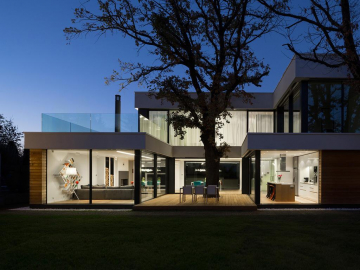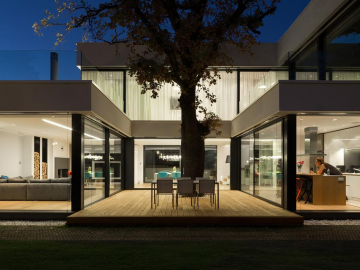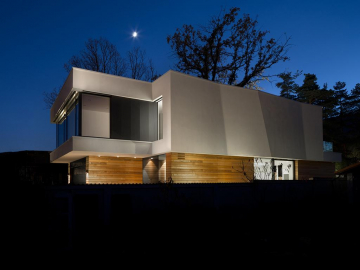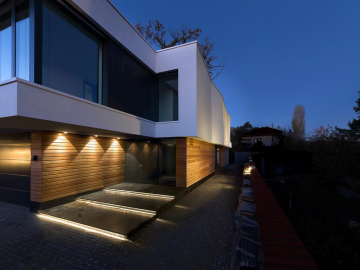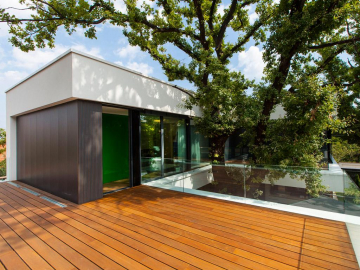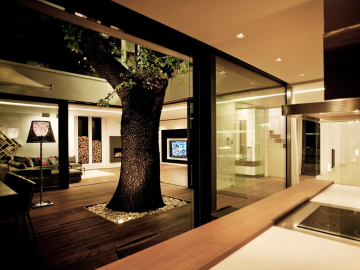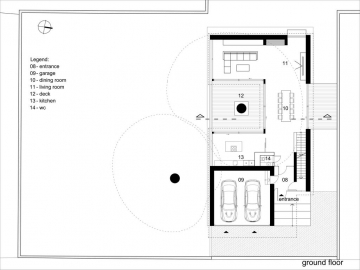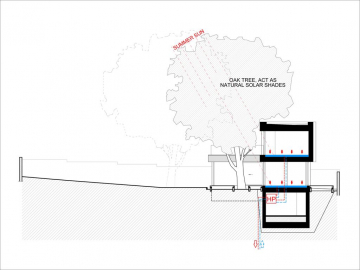2 Oaks House
The house is located in a low-rise suburb in Sofia, in the outskirts of Mountain Vitosha. The project was preliminary defined as a contemporary house with rational spaces, high energy-efficiency and good indoor climate comfort. Main challenge of the design was the preservation of the two existing old oaks and their integration in the spaces of the house. The trees create a natural micro-climate and function as a living element in the composition. The accent in the design concept was defining the space around them. On one hand the house has to be wide-open towards the tree crowns and the yard, and on the other was the desire to emphasize on a certain shell or an envelope explicit and yet very light and airy
, like a paper. Thus, appeared the leading concept - taking the paper theme with the inherent property of folding. It led the design to the white enclosing facade surface of the upper level and the wooden cladding, allowing the paper to levitate.
The factor that determines the shape of the building is the two trees - one of them is its spatial and functional focus. The living zone at the ground level is a single U-shape space, consisting of kitchen, dining room and living room, fully glazed and open towards the yard. Each half of the glazed facade surfaces is a sliding element, so that when all elements are open in summer, the living area turns into covered terrace towards the yard. On this level are also placed the main entrance and a garage for two cars. On the upper level are situated two bedrooms, the master bedroom and a small office. This second level is thoroughly glazed and open towards the trees in a way, that being on it feels like a walk through the crowns on a covered wooden deck.
2 Oaks House is designed with a high level of energy-efficiency, starting from the spatial composition, to the construction and the building systems. Preserving the two existing trees plays a significant role for the thermal balance of a building with highly glazed facades. The oaks serve as a natural protection against overheating in the summer, contributing to the geothermal cooling heat-pump system, which charges the ground with excessive heat (pumped back during the winter season). When the leaves are fallen off in the winter, the low winter sun penetrates deep into the living spaces, charging the thermal mass in the floors, facilitating the heating system.
The main construction had to be rational, economically reasonable, and stable (in active geological region), therefore a typical for the region bearing cast-on-site reinforced concrete skeleton is designed. In order to minimize the size of the constructive elements on the south facade steel tubular columns are used. A special care is taken, considering the thermal insulation of the other shell.
The transparent elements consist of a triple gas-filled glazing (Uw=1W/m2K), and respectively 20-16 cm thick glass-wool thermal insulation on the opaque construction, reaching U-values up to 0.16 W/m2K. Special thermal bridges are separately insulated with custom fabricated Vacuum Insulation Panels( VIPs). The building has a low-temperature floor heating/cooling system with a geothermal heat pump (deep boreholes). For the needs of the indoor air hygiene and the energy-saving a controlled ventilation system with a high level of heat-recovery is integrated in all living areas.
A full-control building automation system allows the user to manage from distance all parameters of the building systems as well as drawing statistics of the way the house and its energy is used over time.

